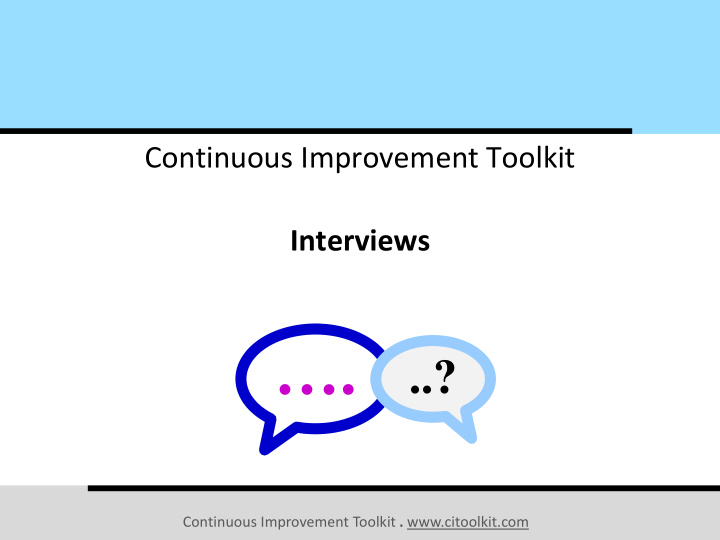



Continuous Improvement Toolkit Interviews …. ..? Continuous Improvement Toolkit . www.citoolkit.com
The Continuous Improvement Map Managing Deciding & Selecting Planning & Project Management* Risk PDPC Decision Balance Sheet Importance-Urgency Mapping Daily Planning PERT/CPM RAID Log* Force Field Analysis Cost Benefit Analysis FMEA MOST RACI Matrix Activity Networks Break-even Analysis Voting TPN Analysis Risk Assessment* SWOT Analysis Stakeholder Analysis Decision Tree Pick Chart Four Field Matrix Fault Tree Analysis Project Charter Improvement Roadmaps Critical-to Tree QFD Portfolio Matrix Traffic Light Assessment PDCA Policy Deployment Gantt Charts DMAIC Paired Comparison Matrix Diagram Kano Analysis Lean Measures Kaizen Events Control Planning Prioritization Matrix Pugh Matrix Cost of Quality* Bottleneck Analysis** A3 Thinking Standard work Document control C&E Matrix Pareto Analysis OEE KPIs Implementing Cross Training Understanding Process Yield ANOVA Chi-Square Descriptive Statistics Solutions** Cause & Effect Value Analysis Capability Indices Probability Distributions Hypothesis Testing Ergonomics Mistake Proofing Design of Experiment Gap Analysis* Multi vari Studies Histograms & Boxplots Automation Simulation TPM Confidence Intervals Reliability Analysis Graphical Analysis Scatter Plots Pull Flow Just in Time Correlation Regression Understanding MSA 5 Whys Run Charts Visual Management 5S Root Cause Analysis Performance Data Snooping Control Charts Quick Changeover Fishbone Diagram Tree Diagram* Waste Analysis Benchmarking** SIPOC* Time Value Map Sampling Morphological Analysis Process Redesign Data collection planner* How-How Diagram** Value Stream Mapping Brainstorming Spaghetti Diagram Check Sheets SCAMPER** Attribute Analysis Interviews Service Blueprints Flow Process Charts Affinity Diagram Questionnaires Relationship Mapping* Focus Groups Data Flowcharting IDEF0 Process Mapping Mind Mapping* Lateral Thinking Observations Collection Creating Ideas Designing & Analyzing Processes Suggestion systems Continuous Improvement Toolkit . www.citoolkit.com
- Interviews An Interview: A technique used to understand the experiences of others (customers, employees, etc.). Takes the form of a conversation between the interviewer and the interviewee. Often conducted in an informal and natural way: • Where the respondent can freely express his/her opinion in his/her own words. …. ..? Continuous Improvement Toolkit . www.citoolkit.com
- Interviews When to Use: To learn about the product or service from the customer’s perspective. In project management and improvement initiatives to learn what is important or confusing (to the customer for example). In journalism and media reporting. When screening candidates for employment. When measuring the employee satisfaction level: • During organizational transformation. • On employee exit. Continuous Improvement Toolkit . www.citoolkit.com
- Interviews Can be undertaken through different media: • Face-to-face. • Telephone. • Email. • Online meetings. Continuous Improvement Toolkit . www.citoolkit.com
- Interviews Data capturing methods: • Forms and questionnaires. • Note taking. • Audiotapes and computer audio programs. Continuous Improvement Toolkit . www.citoolkit.com
- Interviews Types: Open interviews allow a degree of freedom and adaptability in getting the information. Structured interviews are performed by using a well-designed questionnaire. • Forces the respondent to choose answers from among the same set of alternatives. • More focused questions can be asked and data can be more easily analyzed and compared. • More expensive. Continuous Improvement Toolkit . www.citoolkit.com
- Interviews How to Conduct an Interview: Start by clearly define the purpose of the interview. Identify the target respondents for the interview. Prepare a list of questions prior the interview. Decide the type of interview you will use. Decide the data capturing method. Contact the respondents before the interview. Do a pilot interview to refine the questions and the interview process. Continuous Improvement Toolkit . www.citoolkit.com
- Interviews How to Conduct an Interview: Conduct the interview at the scheduled time and date. Let the questions structure the conversation, but adapt to the discussion as needed. Take notes or record the interview. Listen, don’t interrupt, make the participant feel comfortable and be respectful of boundaries. Before completing, ask for additional input or comments. Take time to document important ideas and findings soon after completing the interview. Process and analyze the data. Continuous Improvement Toolkit . www.citoolkit.com
- Interviews Further Information: Establish a rapport with the interviewee in order for him to be open and talk freely. You may clarify questions or ask follow-up questions on the spot to further probe for meaningful data. A test prior the interview will assure better data and avoid wasting time and money. Sometimes, interviews are used to validate data collected previously by other survey methods. Continuous Improvement Toolkit . www.citoolkit.com
Recommend
More recommend